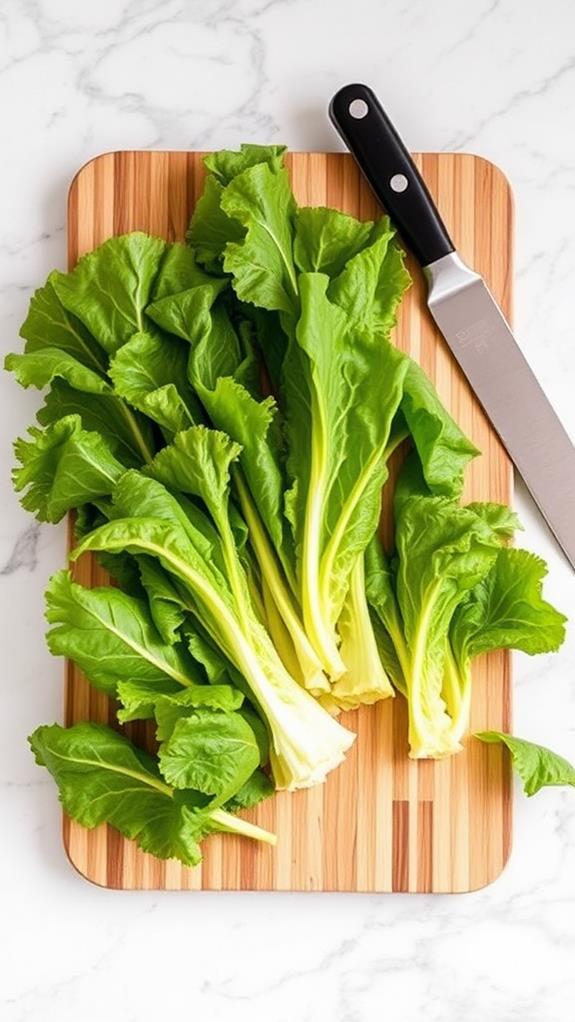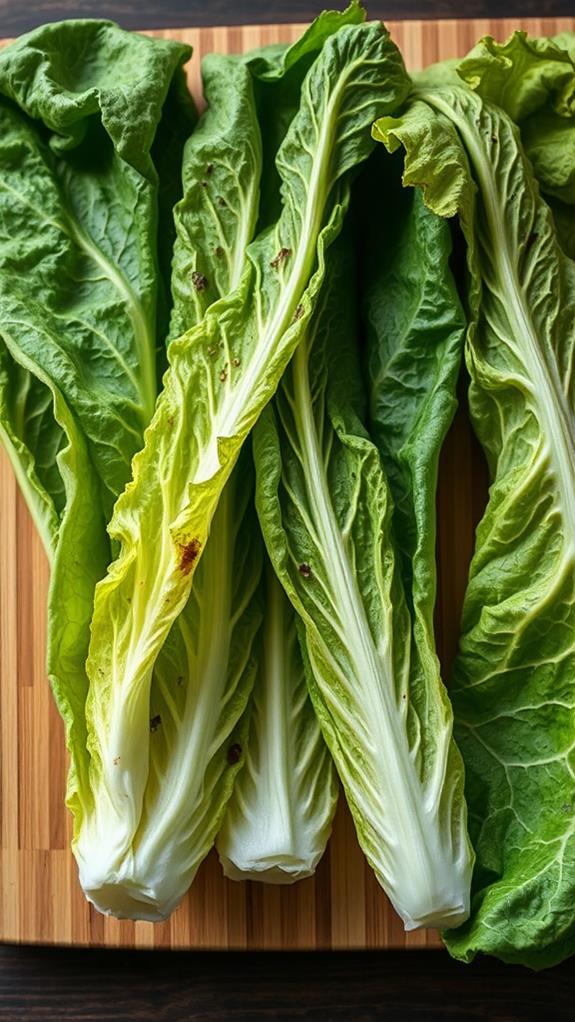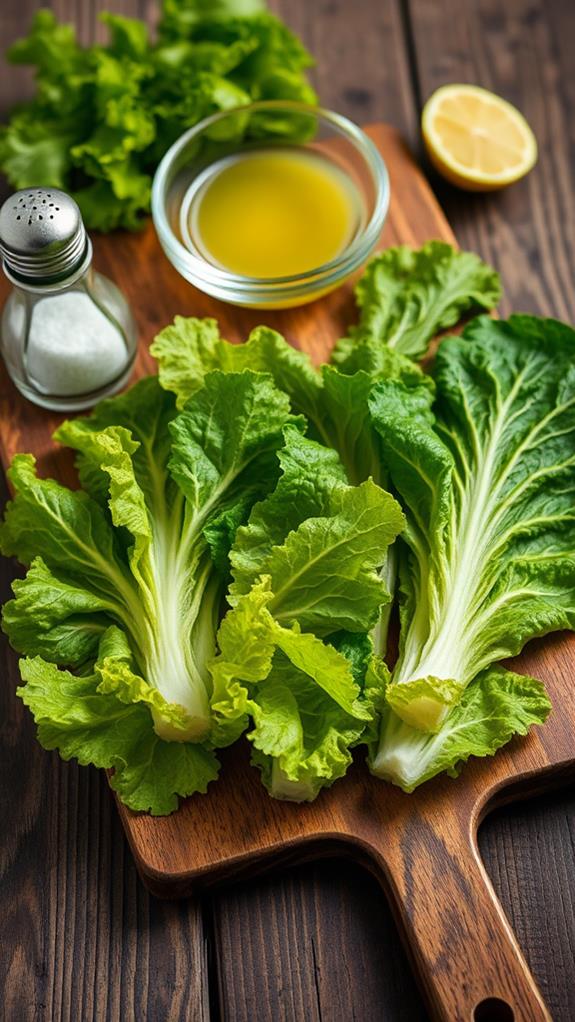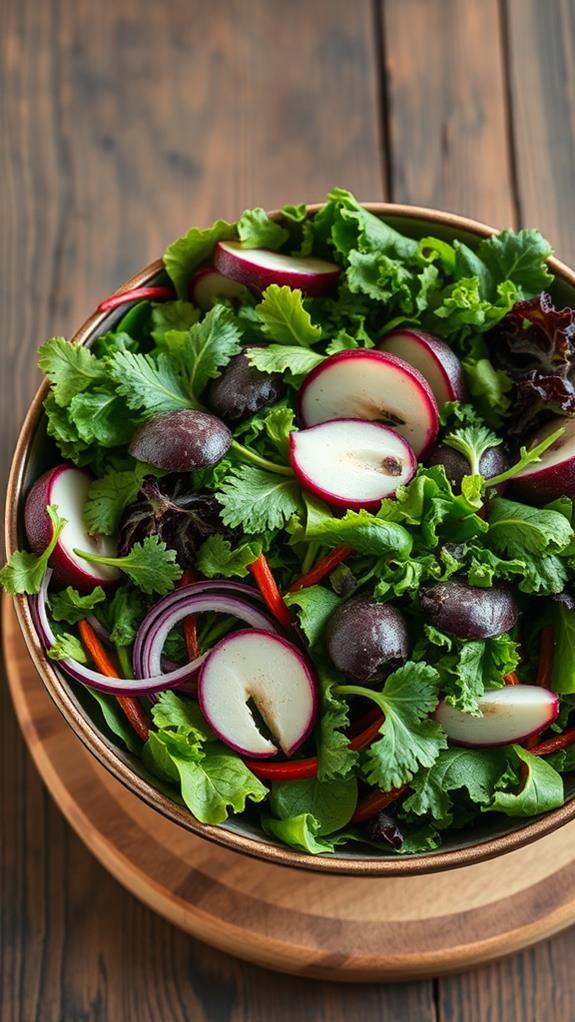Is Bitter Lettuce Safe to Eat
Bitter lettuce is generally safe to eat, despite its unpleasant taste. It contains naturally occurring compounds called sesquiterpene lactones, which aren't harmful to most people and may offer health benefits. Bitter lettuce retains its nutritional value, providing vitamins A, C, K, folate, and minerals like iron and calcium. However, extremely bitter lettuce might cause digestive discomfort in sensitive individuals. You can mitigate bitterness by cooking, adding salt, lemon juice, or vinegar. If you're pregnant or have a sensitive stomach, exercise caution. While bitter lettuce is safe, there are alternatives if you prefer milder flavors. Exploring the causes and nutritional aspects of bitter lettuce can help you make informed choices.
This post may contain affiliate links. If you make a purchase through these links, I may earn a commission at no additional cost to you. Additionally, portions of this post may be generated using artificial intelligence (AI) technology. While we strive for accuracy, please be aware that AI-generated content may not always be perfect and should be fact-checked when necessary.
The Spatula Scoops
- Bitter lettuce is generally safe to eat for most people, containing naturally occurring compounds that may offer health benefits.
- Bitter lettuce retains its nutritional value, providing vitamins A, C, K, folate, and minerals like iron and calcium.
- Extremely bitter lettuce may cause digestive discomfort in sensitive individuals or pregnant women.
- Visual cues like browning edges, wilting, and bolting can help identify bitter lettuce.
- Cooking techniques and ingredient additions can help mitigate the bitter flavor while preserving nutritional benefits.
Safety of Consuming Bitter Lettuce

Bitter lettuce might turn you off, but it's generally safe to eat. The bitterness you taste is often due to naturally occurring compounds called sesquiterpene lactones. These compounds aren't harmful to most people and may even offer health benefits, such as antioxidant and anti-inflammatory properties. Similar to raw Brussels sprouts, bitter lettuce contains high levels of vitamins and minerals that contribute to overall wellness. The nutrient density of these vegetables supports immune function and may help reduce oxidative stress in the body.
However, if you're sensitive to bitter flavors or have certain health conditions, you might want to be cautious. Extremely bitter lettuce could indicate high levels of these compounds, which might cause digestive discomfort in some individuals. If you're pregnant or have a sensitive stomach, it's best to consult with your healthcare provider before consuming very bitter lettuce.
To reduce bitterness, you can try a few methods. Soaking the leaves in cold water for about 30 minutes can help leach out some of the bitter compounds. You can also pair the lettuce with sweeter ingredients or use a tangy dressing to balance the flavor. If the bitterness is overwhelming, it might be best to discard the lettuce, as it could be past its prime or have been exposed to stress during growth, potentially affecting its quality and taste.
Causes of Lettuce Bitterness
Understanding why lettuce becomes bitter can help you prevent or mitigate this issue in your garden or kitchen. Several factors contribute to lettuce bitterness, including environmental conditions, plant age, and cultivation practices.
Heat stress is a primary cause of bitterness in lettuce. When temperatures rise above 80°F (27°C), lettuce plants produce more sesquiterpene lactones, compounds responsible for the bitter taste. Additionally, lack of water can intensify this effect, as stressed plants produce more bitter compounds. Soil quality also plays a role; nutrient imbalances, particularly excess nitrogen, can lead to increased bitterness. Similar to raw corn safety, proper storage and handling of lettuce can help maintain its quality and flavor.
As lettuce matures, it naturally becomes more bitter. This is especially true when the plant begins to bolt, or produce a flowering stalk. The plant redirects energy from leaf production to seed production, altering its chemical composition. Certain varieties, such as romaine and endive, are naturally more bitter than others.
Improper harvesting techniques can also contribute to bitterness. Damage to the plant's tissues during harvesting can release bitter compounds. To minimize bitterness, harvest lettuce in the morning when it's cool and crisp, and handle it gently to avoid bruising.
Identifying Bitter Lettuce

To identify bitter lettuce, you'll want to look for visual signs, perform a taste test, and consider the age and storage of the leaves. Visual cues can include browning edges, wilting, or discoloration, which often indicate bitterness. Similar to green garlic discoloration, these changes in lettuce are primarily due to chemical reactions and environmental factors. Proper storage, such as refrigeration, can help slow down the process that leads to bitterness. You can also take a small bite to assess the flavor, but be aware that some lettuce varieties naturally have a slightly bitter taste. Ultimately, older lettuce or leaves that have been improperly stored are more likely to develop a bitter flavor, so check the purchase date and storage conditions.
Visual Signs
Identifying bitter lettuce through visual cues isn't always straightforward, but there are several tell-tale signs you can look for. First, examine the leaves closely. Bitter lettuce often has thicker, tougher leaves compared to its sweeter counterparts. You'll notice a more pronounced midrib, which is the central vein running through the leaf. The color can also be a giveaway; bitter lettuce tends to have a darker, more intense green hue.
Next, pay attention to the overall appearance of the plant. Bitter lettuce frequently displays signs of bolting, which is when the plant starts to produce a flowering stem. This process alters the lettuce's flavor profile, making it more bitter. Here's a quick reference table for visual cues:
| Visual Cue | Sweet Lettuce | Bitter Lettuce |
|---|---|---|
| Leaf Texture | Tender, crisp | Tough, leathery |
| Color | Light to medium green | Dark, intense green |
| Stem | Short, compact | Tall, elongated |
Lastly, look for any discoloration or brown spots on the leaves. While these don't necessarily indicate bitterness, they can be signs of age or stress, which often correlate with a more bitter taste.
Taste Test
When it comes to identifying bitter lettuce, your taste buds are your most reliable tool. If you suspect your lettuce might be bitter, take a small bite from a leaf. You'll immediately notice a sharp, unpleasant taste that's distinctly different from the mild, crisp flavor of fresh lettuce. This bitterness can range from slightly off-putting to intensely acrid, depending on the lettuce's age and growing conditions.
As you chew, pay attention to the aftertaste. Bitter lettuce often leaves a lingering, unpleasant sensation on your tongue. If you're unsure, compare the taste to a known fresh lettuce leaf. The contrast should be evident. Remember, some lettuce varieties, like radicchio or endive, are naturally bitter, so consider the type you're tasting.
If you're creating content about bitter lettuce, use keywords like "taste test," "bitter flavor," and "lettuce freshness" to improve your search engine optimization (SEO). These terms will help your article rank higher in search results when people look for information on identifying bitter lettuce. By providing clear, detailed descriptions of the taste experience, you'll create valuable, user-friendly content that meets searchers' needs.
Age and Storage
Two key factors in identifying bitter lettuce are its age and storage conditions. As lettuce ages, it naturally becomes more bitter. You'll notice this change in taste as the leaves start to wilt and develop brown edges. The older the lettuce, the more pronounced the bitterness becomes.
Storage plays an essential role in lettuce's flavor profile. Improper storage can accelerate the bitter-producing process. When you store lettuce at temperatures that are too warm or in high-humidity environments, it can lead to rapid deterioration and increased bitterness. To maintain freshness and minimize bitterness, store your lettuce in the crisper drawer of your refrigerator, wrapped loosely in a plastic bag with a few air holes.
It's important to note that some varieties of lettuce, like radicchio or endive, are naturally more bitter than others. However, even these types shouldn't have an overwhelmingly bitter taste when fresh. If you're unsure about your lettuce's age or storage history, perform a visual inspection and smell test. Discoloration, slimy texture, or an off-putting odor are clear indicators that your lettuce has gone bad and should be discarded.
Nutritional Value of Bitter Lettuce
Despite its bitter taste, lettuce that's turned slightly bitter still packs a nutritional punch. You'll find that bitter lettuce retains most of its nutritional value, offering a range of vitamins and minerals. It's particularly rich in vitamin K, which is indispensable for blood clotting and bone health. You'll also get a good dose of vitamin A, important for eye health and immune function.
Bitter lettuce contains folate, a B-vitamin essential for cell growth and DNA synthesis. It's also a source of vitamin C, an antioxidant that supports your immune system and skin health. The bitterness itself comes from compounds called sesquiterpene lactones, which some studies suggest may have anti-inflammatory and anti-cancer properties.
You'll benefit from the fiber content in bitter lettuce, which aids digestion and promotes feelings of fullness. It's also low in calories, making it a great option for weight management. The lettuce's high water content helps with hydration. While the taste might be off-putting, you're still getting valuable nutrients. If the bitterness is too intense, you can mix it with other greens or use it in cooked dishes to balance the flavor.
Mitigating Lettuce Bitterness

If you're looking to reduce the bitterness in your lettuce, there are several effective methods you can try. Cooking bitter lettuce can help mellow its flavor, as heat breaks down some of the compounds responsible for the sharp taste. You can also experiment with salt and acid tricks, such as sprinkling a pinch of salt on the leaves or adding a splash of lemon juice or vinegar to your salad dressing, which can help balance and counteract the bitter notes.
Cooking Bitter Lettuce
Wondering how to tame that bitter lettuce in your fridge? Cooking can be an effective method to reduce the bitterness and make your lettuce more palatable. You've got several options to choose from, depending on your preferences and the dish you're preparing.
One popular technique is to sauté the lettuce. Heat some oil in a pan, add chopped garlic for flavor, and quickly cook the lettuce until it wilts. This process can help mellow out the bitter compounds. Alternatively, you can braise the lettuce by simmering it in a flavorful liquid, such as chicken or vegetable broth. This method not only reduces bitterness but also infuses the lettuce with additional flavors.
Grilling is another option that can transform bitter lettuce. Brush the leaves with oil, season them, and grill for a few minutes on each side. The heat caramelizes some of the sugars in the lettuce, balancing out the bitterness. For a different approach, try incorporating bitter lettuce into soups or stews. The long cooking process and mixing with other ingredients can help mask the bitter taste while retaining the nutritional benefits.
Salt and Acid Tricks
A sprinkle of salt or a splash of acid can work wonders on bitter lettuce. When you're faced with an overly bitter bunch, these simple tricks can help balance the flavor. Salt, in particular, can mask bitterness by stimulating other taste receptors on your tongue. You'll want to use it sparingly; a light dusting is often enough to counteract the bitter compounds.
Acids, such as lemon juice or vinegar, work differently. They don't mask the bitterness but instead provide a contrasting flavor that can make the overall taste more palatable. You can create a simple vinaigrette by mixing olive oil with your chosen acid, which will coat the leaves and distribute the flavor evenly.
For ideal results, combine these methods. After washing your lettuce, dry it thoroughly and sprinkle it lightly with salt. Then, dress it with an acidic vinaigrette just before serving. This two-pronged approach can considerably reduce perceived bitterness while enhancing the overall flavor profile of your salad. Remember, the goal is to balance the taste, not to completely eliminate the natural bitterness that gives lettuce its character.
Health Benefits of Bitter Greens
Despite their sometimes off-putting taste, bitter greens pack a powerful nutritional punch. You'll find that incorporating these vegetables into your diet can provide numerous health benefits. Bitter greens are rich in vitamins, minerals, and antioxidants that support your overall well-being.
Here's a breakdown of some common bitter greens and their key nutrients:
| Bitter Green | Vitamin A | Vitamin C | Vitamin K | Fiber | Antioxidants |
|---|---|---|---|---|---|
| Kale | High | High | Very High | High | Very High |
| Arugula | Moderate | High | High | Low | High |
| Dandelion | High | Moderate | Very High | High | High |
| Radicchio | Low | Moderate | High | Low | High |
| Endive | Moderate | Moderate | High | Low | Moderate |
These nutrient-dense greens can help boost your immune system, support bone health, and aid in digestion. They're also known for their potential anti-inflammatory and cancer-fighting properties. You'll find that regularly consuming bitter greens may contribute to improved heart health and better blood sugar control. While the bitterness might take some getting used to, the health benefits make it worth incorporating these powerhouse vegetables into your meals.
Alternatives to Bitter Lettuce

For those who find bitter lettuce unpalatable, plenty of alternatives can provide similar nutritional benefits without the harsh taste. You might consider milder leafy greens like spinach, romaine, or butter lettuce. These options offer comparable nutrient profiles, including vitamins A, C, and K, as well as folate and fiber.
If you're looking for a crunchier texture, try iceberg lettuce or crisp cabbage varieties. While they're not as nutrient-dense as darker greens, they still contribute to your daily vegetable intake. For a nutrient boost, you can mix these milder options with small amounts of more flavorful greens like arugula or watercress.
Kale and Swiss chard are excellent alternatives that, when prepared properly, can be less bitter than some lettuce varieties. Massaging kale with a bit of oil and lemon juice can help break down its tough fibers and reduce bitterness. You might also explore non-leafy vegetables like bell peppers or cucumbers for salads, providing different flavors and textures while still offering nutritional benefits. Guarantee you're getting a wide range of nutrients and can help you avoid palate fatigue.
Frequently Asked Questions
Can Bitter Lettuce Be Used in Cooking Recipes?
Yes, you can use bitter lettuce in cooking recipes. It's a versatile ingredient that adds a unique flavor profile to various dishes. You'll find it works well in salads, soups, and stir-fries. To reduce bitterness, try blanching or sautéing the lettuce before incorporating it into your recipe. You can also pair it with sweeter ingredients or use it as a complement to rich, savory flavors. Don't hesitate to experiment with bitter lettuce in your culinary creations.
Does Bitter Lettuce Have a Longer Shelf Life Than Regular Lettuce?
You'll find that bitter lettuce doesn't necessarily have a longer shelf life than regular lettuce. In fact, its shelf life might be shorter. The bitterness often indicates that the lettuce is past its prime or has been exposed to stress, which can accelerate spoilage. To maximize your lettuce's lifespan, store it properly in the refrigerator's crisper drawer, wrapped in a damp paper towel inside a plastic bag. This method helps maintain freshness for both bitter and regular lettuce varieties.
Are There Specific Varieties of Lettuce That Are Naturally More Bitter?
Yes, there are specific lettuce varieties that are naturally more bitter. You'll find that some types, like endive, radicchio, and escarole, have a distinctly bitter taste. Arugula, while technically not lettuce, is often grouped with salad greens and has a peppery, bitter flavor. Even within common lettuce varieties, outer leaves tend to be more bitter than inner ones. The bitterness in these lettuces comes from compounds called sesquiterpene lactones, which can vary in concentration depending on growing conditions and age.
Can Animals Safely Consume Bitter Lettuce?
When it comes to animals consuming bitter lettuce, you'll find that most can safely eat it. However, the effects may vary depending on the animal species. Domesticated pets like rabbits and guinea pigs can generally handle bitter lettuce without issues. For livestock, such as cattle or goats, bitter lettuce is often consumed without harm. Wild animals, including deer and various birds, may also eat bitter lettuce. It is crucial to acknowledge that while safe, some animals might avoid bitter lettuce due to taste preferences.
Does the Bitterness of Lettuce Change When It's Cooked or Steamed?
When you cook or steam bitter lettuce, you'll notice a change in its taste. The heating process breaks down some of the compounds responsible for bitterness, resulting in a milder flavor. You'll find that steaming often preserves more of the original taste, while cooking methods like sautéing or grilling can substantially reduce bitterness. Nonetheless, it bears mentioning that cooking won't completely eliminate all bitter notes, especially in very bitter varieties of lettuce.
Conclusion
You've learned that bitter lettuce is safe to savor. While it's not always appetizing, you can alleviate the astringent taste through various techniques. Remember, bitterness doesn't diminish the nutritional benefits; in fact, it might magnify them. If you're still not fond of the flavor, fear not. You can find fabulous alternatives or focus on the health perks of bitter greens. Ultimately, it's your choice to consume or compost, but you're now equipped with the knowledge to make an informed decision.





